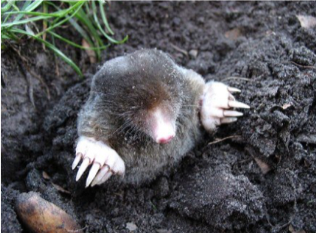If you have a cat, you know this scenario. The cat door opens, Pudda comes in, there’s a moment of silence, followed by complete mayhem. Chasing, scurrying, chirping (the cat), and if you’re really lucky, the plop of a small gift at (or on) your foot. Followed by you trying to catch said gift and return it to the great outdoors. My cat has a propensity for catching voles and mice. She listens attentively for hours until she can pounce and capture. (She’s like a Labrador, very soft mouth, the victims almost always live.) Fortunately, though, neither she nor most cats can root and catch moles. Mole saliva contains a toxin that paralyzes their favorite prey - earthworms. Eating a mole would definitely merit a visit to the nearest patch of grass.
Moles are impressive little creatures. They can dig up to 18 feet in an hour, eat their weight in earthworms in a day, and although they don’t see very well, they have excellent hearing. Their tunneling is good for aerating the soil, and along the way, they eat grubs and pests. From a science perspective, mole hemoglobin enables them to recycle oxygen so they can live quite comfortably in a high level of tunnel carbon dioxide.
As writers and artists, we sometimes have tunnel vision. We’re so focused on a project that it’s difficult to step back and gain a fresh perspective. When we’re “on a roll” writing we continue full steam ahead for sure, but now and then, it’s good to revisit that project in the light of day. I’m not suggesting we self-edit or critique during creative moments. Instead, I like to step back and look at the overall arc and flow, often realizing that a particular line or scene can work unexpectedly well other than where I originally intended. It’s good to look up and out now and then, before continuing to tunnel through “dirt, rock, and weeds” to reach that artistic light at the end.
Photo credit: Pixabay
Supporting articles:
